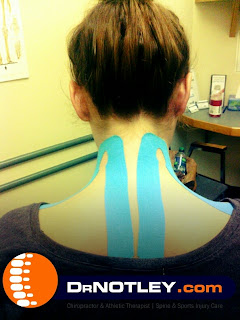This weekend I volunteered my time at Crossfit Winnipeg for their competition, Frostfit. Last year at the same event I was treating a number of shoulder problems. This year the trend was the use of Kinesio Tape (other names for it being Spidertech tape, Rock tape, K-tape).
The use of Kinesio tape has been around since the 80s. More recently, it has been popularized in sports such as volleyball, diving and Crossfit. It is often used for musculoskeletal injuries, swelling and pain.
Over the last year I have started trying it out in my practise. I have had the most success using it with patients with nerve/radicular pain and chronic myofascial pain.
I decided to see what the literature says about the effects of kinesio tape on musculoskeletal pain. The following research papers are by no means a complete review of literature. I have purposely not included case studies. Take some time to read the following abstracts.
My Conclusion
There seems to be some benefit for the use of kinesio tape (decreased pain and increased range of motion) but the benefits tend towards being small benefits. I figure using it as part of a complete treatment program may be where it would benefit most rather than just a stand alone treatment.
Dr Notley
Winnipeg Chiropractor and Athletic Therapist
The Research
The Clinical Efficacy of Kinesio Tape for Shoulder Pain: A Randomized,Double-Blinded, Clinical Trial
MARK D. THELEN, PT, DSc, OCS JAMES A. DAUBER, PT, DPT, DSc, OCS PAUL D. STONEMAN, PT, PhD, OCS
STUDY DESIGN: Prospective, randomized, double-blinded, clinical trial using a repeated-measures design.
OBJECTIVES: To determine the short-term clinical efficacy of Kinesio Tape (KT) when applied to college students with shoulder pain, as compared to a sham tape application.
BACKGROUND: Tape is commonly used as an adjunct for treatment and prevention of musculoskeletal injuries. A majority of tape applications that are reported in the literature involve non-stretch tape. The KT method has gained significant popularity in recent years, but there is a paucity of evidence on its use.
METHODS AND MEASURES: Forty-two subjects clinically diagnosed with rotator cuff tendonitis/impingement were randomly assigned to 1 of 2 groups: therapeutic KT group or sham KT group. Subjects wore the tape for 2 consecutive 3-day intervals. Self-reported pain and disability and pain-free active range of motion (ROM) were measured at multiple intervals to assess for differences between groups.
RESULTS: The therapeutic KT group showed immediate improvement in pain-free shoulder abduction (mean P= .005) after tape application. No other differences between groups regarding ROM, pain, or disability scores at any time interval were found.
CONCLUSION: KT may be of some assistance to clinicians in improving pain-free active ROM immediately after tape application for patients with shoulder pain. Utilization of KT for decreasing pain intensity or disability for young patients with suspected shoulder tendonitis/impingement is not supported.
Kinesio taping compared to physical therapy modalities for the treatment of shoulder impingement syndrome
Erkan Kaya, Murat Zinnuroglu, Ilknur Tugcu
The purpose of this study was to determine and compare the efficacy of kinesio tape and physical therapy modalities in patients with shoulder impingement syndrome. Patients (n = 55) were treated with kinesio tape (n = 30) three times by intervals of 3 days or a daily program of local modalities (n = 25) for 2 weeks. Response to treatment was evaluated with the Disability of Arm, Shoulder, and Hand scale. Patients were questioned for the night pain, daily pain, and pain with motion. Outcome measures except for the Disability of Arm, Shoulder, and Hand scale were assessed at baseline, first, and second weeks of the treatment. Disability of Arm, Shoulder, and Hand scale was evaluated only before and after the treatment. Disability of Arm, Shoulder, and Hand scale and visual analog scale scores decreased significantly in both treatment groups as compared with the baseline levels. The rest, night, and movement median pain scores of the kinesio taping (20, 40, and 50, respectively) group were statistically significantly lower (p values were 0.001, 0.01, and 0.001, respectively) at the first week examination as compared with the physical therapy group (50, 70, and 70, respectively). However, there was no significant difference in the same parameters between two groups at the second week (0.109, 0.07, and 0.218 for rest, night, and movement median pain scores, respectively). Disability of Arm, Shoulder, and Hand scale scores of the kinesio taping group were significantly lower at the second week as compared with the physical therapy group. No side effects were observed. Kinesio tape has been found to be more effective than the local modalities at the first week and was similarly effective at the second week of the treatment. Kinesio taping may be an alternative treatment option in the treatment of shoulder impingement syndrome especially when an immediate effect is needed.
Short-term effects of cervical kinesio taping on pain and cervical range of motion in patients with acute whiplash injury: a randomized clinical trial.
González-Iglesias J, Fernández-de-Las-Peñas C, Cleland JA, Huijbregts P, Del Rosario Gutiérrez-Vega M Centor de Fisioterapia Integral, Candas, Asturias, Spain.
The Journal of Orthopaedic and Sports Physical Therapy [2009, 39(7):515-521]
OBJECTIVES: To determine the short-term effects of Kinesio Taping, applied to the cervical spine, on neck pain and cervical range of motion in individuals with acute whiplash-associated disorders (WADs).
BACKGROUND: Researchers have begun to investigate the effects of Kinesio Taping on different musculoskeletal conditions (eg, shoulder and trunk pain). Considering the demonstrated short-term effectiveness of Kinesio Tape for the management of shoulder pain, it is suggested that Kinesio Tape may also be beneficial in reducing pain associated with WAD.
METHODS AND MEASURES: Forty-one patients (21 females) were randomly assigned to 1 of 2 groups: the experimental group received Kinesio Taping to the cervical spine (applied with tension) and the placebo group received a sham Kinesio Taping application (applied without tension). Both neck pain (11-point numerical pain rating scale) and cervical range-of-motion data were collected at baseline, immediately after the Kinesio Tape application, and at a 24-hour follow-up by an assessor blinded to the treatment allocation of the patients. Mixed-model analyses of variance (ANOVAs) were used to examine the effects of the treatment on each outcome variable, with group as the between-subjects variable and time as the within-subjects variable. The primary analysis was the group-by-time interaction.
RESULTS: The group-by-time interaction for the 2-by-3 mixed-model ANOVA was statistically significant for pain as the dependent variable (F = 64.8; P<.001), indicating that patients receiving Kinesio Taping experienced a greater decrease in pain immediately post application and at the 24-hour follow-up (both, P<.001). The group-by-time interaction was also significant for all directions of cervical range of motion: flexion (F = 50.8; P<.001), extension (F = 50.7; P<.001), right (F = 39.5; P<.001) and left (F = 3.8, P<.05) lateral flexion, and right (F = 33.9, P<.001) and left (F = 39.5, P<.001) rotation. Patients in the experimental group obtained a greater improvement in range of motion than those in the control group (all, P<.001).
CONCLUSIONS: Patients with acute WAD receiving an application of Kinesio Taping, applied with proper tension, exhibited statistically significant improvements immediately following application of the Kinesio Tape and at a 24-hour follow-up. However, the improvements in pain and cervical range of motion were small and may not be clinically meaningful. Future studies should investigate if Kinesio Taping provides enhanced outcomes when added to physical therapy interventions with proven efficacy or when applied over a longer period.
Castro-Sánchez AM, Lara-Palomo IC, Matarán-Peñarrocha GA, Fernández-Sánchez M, Sánchez-Labraca N, Arroyo-Morales
Question: Does Kinesio Taping reduce disability, pain, and kinesiophobia in people with chronic non-specific low back pain?
Design: Randomised trial, with concealed allocation, assessor blinding, and intention-to-treat analysis.
Participants: Sixty adults with chronic non-specific low back pain. Intervention: The experimental intervention was Kinesio Taping over the lumbar spine for one week; the control intervention was sham taping.
Outcome measures: The following outcomes were measured at baseline, immediately after the week with the tape in situ, and four weeks later: Oswestry Disability Index, Roland-Morris Low Back Pain and Disability Questionnaire, pain on a 10-cm visual analogue scale, Tampa kinesiophobia scale, trunk flexion range of motion, and the McQuade test of trunk muscle endurance. Results: At one week, the experimental group had significantly greater improvement in disability, by 4 points (95% CI 2 to 6) on the Oswestry score and by 1.2 points (95% CI 0.4 to 2.0) on the Roland-Morris score. However, these effects were not significant four weeks later. The experimental group also had a greater decrease in pain than the control group immediately after treatment (mean between-group difference 1.1 cm,
95% CI 0.3 to 1.9), which was maintained four weeks later (1.0 cm, 95% CI 0.2 to 1.7). Similarly trunk muscle endurance was significantly better at one week (by 23 sec, 95% CI 14 to 32) and four weeks later (by 18 sec, 95% CI 9 to 26). Other outcomes were not significantly affected.
Conclusion: Kinesio Taping reduced disability and pain in people with chronic non-specific low back pain, but these effects may be too small to be clinically worthwhile.
The Effect of Kinesio Taping on Lower Trunk Range of Motions
Ayako Yoshida & Leamor Kahanov
Research in Sports Medicine Volume 15, Issue 2, 2007, pages 103- 112
ABSTRACT The purpose of the study was to determine the effects of kinesio taping (KT) on trunk flexion, extension, and lateral flexion. Thirty healthy subjects with no history of lower trunk or back issues participated in the study. Subjects performed two experimental measurements of range of motion (with and without the application of KT) in trunk flexion, extension, and right lateral flexion. A dependent t test was used to compare the range of motion measurements before and after the application of KT. Through evaluation of the sum of all scores, KT in flexion produced a gain of 17.8 cm compared with the non-kinesiotape group (t (29) = 2.51, p < 0.05). No significant difference was identified for extension (−2.9 cm; t (29) = −0.55, p > 0.05) or lateral flexion (3 cm; t (29) = −1.25, p > 0.05). Based on the findings, we determined that KT applied over the lower trunk may increase active lower trunk flexion range of motion. Further investigation on the effects of KT is warranted. —
The Effect of Kinesiotape on Function, Pain, and Motoneuronal Excitability in Healthy People and People With Achilles Tendinopathy
Firth, Bridget L BSc; Dingley, Paul BSc; Davies, Elizabeth R BSc; Lewis, Jeremy S PhD; Alexander, Caroline M PhD
Objective: To investigate the effect of kinesiotape on hop distance, pain, and motoneuronal excitability in healthy people and people with Achilles tendinopathy (AT).
Design: Within-subject design. Setting: An academic health science center, which is an acute London National Health Service trust. Participants: With ethical approval and informed consent, a convenience sample of 26 healthy people and 29 people with AT were recruited. Seven participants were lost after functional testing, leaving 24 participants in each group. Interventions: Kinesiotape applied over the Achilles tendon.
Main Outcome Measures: The single-leg hop test and visual analog scale were measured with and without the tape. Using the Hoffman (H) reflex, change in motoneuronal excitability of calf muscles was measured before tape application, with the tape on and after its removal.
Results: There were no changes to hop distance when tape was applied (P = 0.55). Additionally, there were no changes to pain (P = 0.74). The H reflex amplitude of soleus and gastrocnemius increased in the healthy group after its removal (P = 0.01 and P = 0.03, respectively), whereas the H reflex remained unchanged in people with AT (P = 0.43 and 0.16, respectively).
Originally posted on May 17, 2022 @ 4:37 pm

